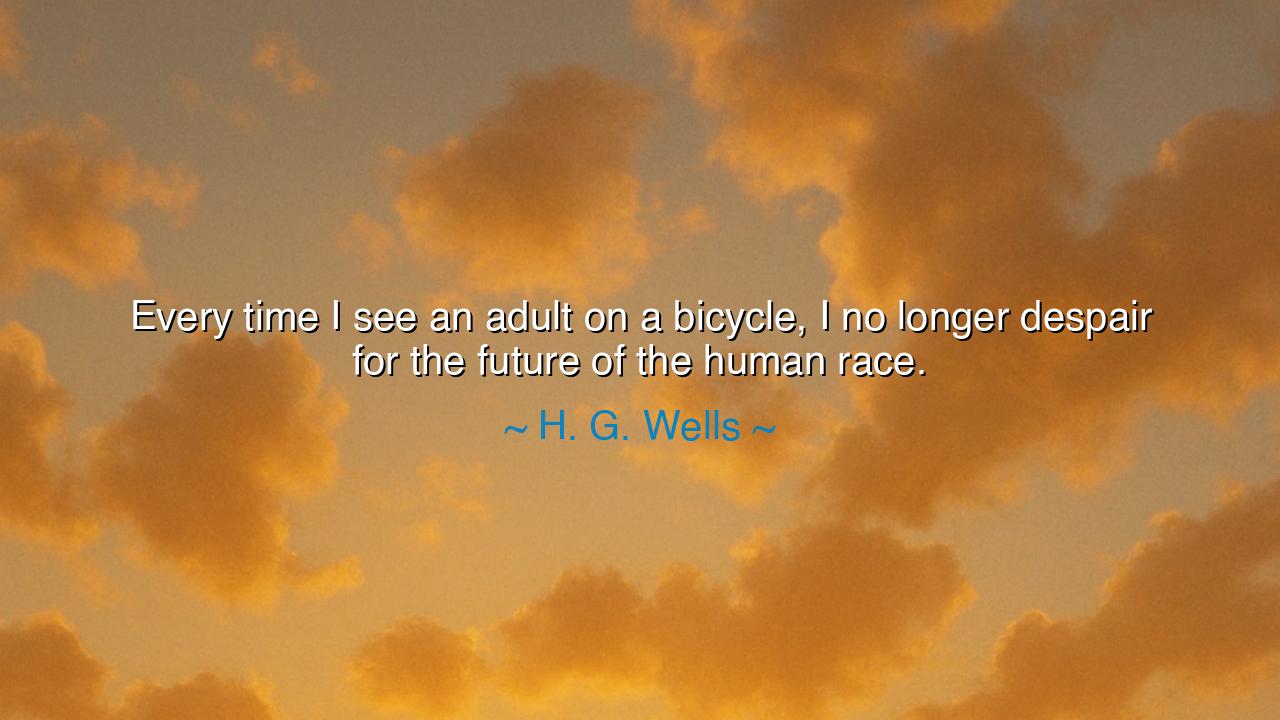
Every time I see an adult on a bicycle, I no longer despair for
Every time I see an adult on a bicycle, I no longer despair for the future of the human race.






“Every time I see an adult on a bicycle, I no longer despair for the future of the human race.”
— H. G. Wells
In these gentle yet profound words, H. G. Wells, the great visionary of science and the author of The Time Machine and The War of the Worlds, reveals not merely his affection for invention, but his faith in humanity’s enduring spirit. The image he paints is simple: an adult, astride a humble bicycle, gliding forward under their own strength. Yet within this image lies a quiet philosophy—a belief that progress, hope, and balance still live in the human heart. For Wells, the sight of an adult pedaling through the world is a symbol of renewal, a sign that humankind has not surrendered entirely to greed, destruction, or despair. The bicycle, in his eyes, becomes more than a machine; it becomes a testament to human simplicity, freedom, and harmony.
The origin of this quote lies in the late nineteenth and early twentieth centuries, an age of astonishing technological upheaval. Wells lived in a time when industrial smoke blackened the skies and cities grew louder, faster, and more mechanical. The world was marching toward the future with great ambition—but also with perilous blindness. Machines promised power, yet they also consumed nature and estranged man from the simple joys of movement and wonder. Amid that turmoil, Wells saw in the bicycle a kind of antidote: a tool that, though mechanical, still kept humanity close to the earth, dependent on its own muscles, guided by wind, and carried by will. To see an adult on a bicycle, then, was to see hope itself made visible—hope that progress could still serve joy rather than domination.
When Wells speaks of despair, he speaks as a prophet weary of humanity’s arrogance. He had written of wars between worlds, of time travel, and of futures where mankind’s own inventions turned against him. Yet, even amid such warnings, he never lost faith in human adaptability. The bicycle, to him, represented a balance between past and future—between nature and invention, simplicity and progress. It is powered by the rider, not by fuel or flame. It moves quietly, leaving no scar upon the land. In that, Wells saw a model of coexistence—a symbol that the human race, though flawed, might yet learn to live wisely within the world it has built.
There is a deep emotional wisdom hidden in this image. To see an adult on a bicycle is to witness a reunion between discipline and delight, the union of maturity and childlike wonder. The adult, often burdened with care, worry, and duty, rediscovers through the act of cycling the lightness of being alive. The motion itself becomes meditation—the turning of wheels like the turning of the earth, the steady rhythm of the body in harmony with the road. For Wells, such a moment was proof that mankind still remembered how to live freely. When adults can still find joy in simple motion, the future cannot be entirely lost.
History, too, affirms his sentiment. Consider the story of the Dutch people after the Second World War. Their cities had been bombed, their spirits scarred. Yet when peace came, they rebuilt not merely with steel and stone, but with bicycles. In Amsterdam, Rotterdam, and Utrecht, the bicycle became a symbol of recovery—a quiet defiance against war and pollution, a restoration of harmony between man and his environment. Even today, as the world faces the crises of climate and consumption, the Dutch streets filled with bicycles stand as living proof of Wells’s vision: that the future belongs not to those who conquer, but to those who move with balance.
Wells’s words, though spoken over a century ago, echo louder now than ever. The adult on a bicycle is a symbol of sustainability, mindfulness, and humility—qualities our modern age desperately needs. In a world racing toward artificial power and endless consumption, to choose a bicycle is to reclaim humanity’s connection with the earth. It is a declaration that progress does not require destruction, that one can move swiftly without leaving scars behind. In every quiet journey of a cyclist, there is a whisper of rebellion—a statement that life’s truest joys are found not in possession or domination, but in simplicity and motion.
So, my listener, take this teaching into your heart: hope lives in the humble and the human. Do not despise the small acts that seem insignificant. To ride a bicycle, to walk, to plant a tree, to speak kindly—these are the revolutions that endure when empires crumble. If despair for the human race ever finds you, look not to grand inventions or distant stars for comfort, but to the sight of someone living in harmony with their world. Be that person yourself. Find your bicycle, whatever it may be—your simple act that keeps you connected to life, to nature, to movement.
And thus, as H. G. Wells reminds us, even in an age of chaos, the future is not lost. As long as there are those who move with grace, who live simply, who remember that joy is found not in power but in balance, the human spirit will endure. The turning of the bicycle’s wheel is the turning of hope itself—quiet, persistent, eternal.






AAdministratorAdministrator
Welcome, honored guests. Please leave a comment, we will respond soon